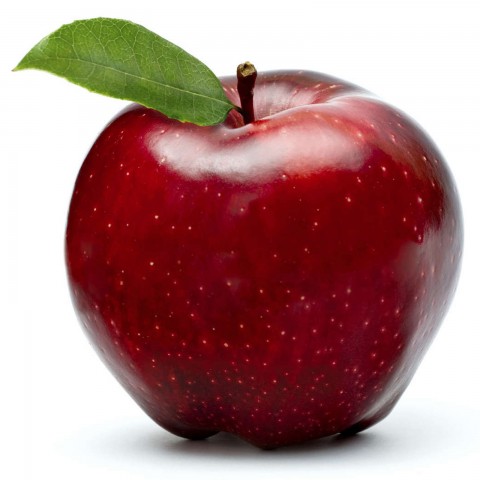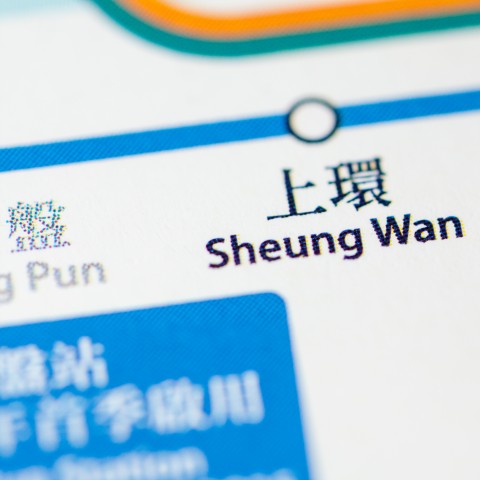
Have you ever wanted to say something in Korean, but you just couldn’t express it because you struggled to structure sentences in your head?
We feel you.
In fact, every language-learner will experience this at some point. But don’t worry anymore; as long as you master these basic Korean sentence patterns, you’ll be able to express yourself much more easily and generate hundreds of natural sentences with ease and confidence.
 Table of Contents
Table of Contents
- Linking Two Nouns: “A is B.”
- Using Adjectives to Describe Nouns: “A is (Adjective)”
- Various Korean Sentence Structures to Express “Want”
- Various Sentence Patterns to Say You Like Something
- Politely Asking Someone to Do Something
- Asking for Permission
- Asking for Information About Something with “What is…”
- Asking About Location or Position: Where is …?
- Asking About Time: When is …?
- Study Korean with KoreanClass101.com

사과는 과일이에요. (Sagwaneun gwairieyo.) — “Apple is a fruit.”
1. Linking Two Nouns: “A is B.”
1. 사과는 과일이에요. (Sagwaneun gwairieyo.) — “Apple is a fruit.”
| Rules: 1. When the last syllable of the noun ends with a consonant: (noun)은 (noun) 이에요. (iyeyo) 2. When the last syllable of the noun ends with a vowel: (noun)은 (noun) 예요. (yeyo) |
Examples:
- 이것은 레몬이에요. (Igeoseun remonieyo.) — “This is a lemon.”
- 이 아이는 학생이에요. (I aineun haksaengieyo.) — “This person is a student.”
- 존은 저의 친구예요. (Joneun jeoui chinguyeyo.) — “John is my friend.”
- 유미는 저의 여자친구에요. (Yumineun jeoui yeojachingueyo.) — “Yumi is my girlfriend.”
- 이 분은 우리 어머니예요. (I buneun uri eomeoniyeyo.) — “This is my mother.”
- 내 친구는 택시 드라이버예요. (Nae chinguneun taeksi deuraibeoyeyo.) — “My friend is a taxi driver.”
- 이 시계는 우리 부모님이 주신 시계예요. (I sigyeneun uri bumonimi jusin sigyeyeyo.) — “My parents bought this watch.”
2. 비빔밥은 한식이야. (Bibimbabeun hansigiya.) — “Bibimbap is a Korean food.”
| Rules: 1. When the last syllable of the noun ends with a consonant: (noun)은 (noun) 이야. 2. When the last syllable of the noun word ends with a vowel: (noun)는 (noun) 이야. |
Here’s a brief explanation of the Korean sentence rules above:
You want to say: “Alice is a person.”
In Korean, “Alice” is written as 앨리스 (aelliseu) and “person” is 사람 (saram).
The Korean sentence pattern for “A is B” is (noun)은 (noun) 이야.
Let’s put each word inside the parentheses, making the full sentence: 앨리스는 사람이야 (Aelliseuneun saramiya).
Examples:
- 존은 나의 친구야. (Joneun naui chinguya.) — “John is my friend.”
- 유미는 나의 여자친구야. (Yumineun naui yeojachinguya.) — “Yumi is my girlfriend.”
- 이 분은 우리 어머니야. (I buneun uri eomeoniya.) — “This is my mother.”
- 내 친구는 택시 드라이버야. (Nae chinguneun taeksi deuraibeoya.) — “My friend is a taxi driver.”
- 이 시계는 우리 부모님이 주신 시계야. (I sigyeneun uri bumonimi jusin sigyeya.) — “My parents bought this watch.”
Check out the Basic Korean Grammar page on our website for more basic Korean sentence structure practice.

이 아이스크림 너무 맛있어요. “This ice cream tastes great.”
2. Using Adjectives to Describe Nouns: “A is (Adjective)”
| Rules: 1. If the vowel is not ㅏor ㅗ, add 어요 (eoyo): A은/는 Adjective어요. 2. If the vowel is ㅏor ㅗ, add 아요 (ayo): A은/는 Adjective아요. |
Examples:
- 이 요리는 맛있어요. (I yorineun masisseoyo.) — “This dish is delicious.”
- 앨리스는 키가 커요. (Aelliseuneun kiga keoyo.) — “Alice is tall.”
- 애드리언은 잘생어요.(Aedeurieoneun jalsaengeoyo.) — “Adrien is handsome.”
- 광희는 재미있어요. (Gwanghuineun jaemiisseoyo.) — “Gwanghee is funny.”
- 스마트폰은 빨라요. (Seumateuponeun ppallayo.) — “Smartphones are fast.”
- 이 사람은 말이 많아요. (I sarameun mari manayo.) — “This person talks a lot.”
Want to learn more adjectives? Check out “Which Adjective Describes Your Personality Best?” and “Most Common Adjectives” on our website!

너무 많은것을 갖고 싶어요. “I want to have so many things!”
3. Various Korean Sentence Structures to Express “Want”
1. 인형을 갖고 싶어요. (Inhyeongeul gatgo sipeoyo.) — “I want to have a doll.”
When you want to have something, use this Korean sentence construction.
| Rules: 1. When the last syllable of the noun ends with a consonant: (noun) 을 갖고 싶어요. (~eul gatgo sipeoyo.) 2. When the last syllable of the noun ends with a vowel: (noun) 를 갖고 싶어요. (~reul gatgo sipeoyo.) |
Explanation:
If you want to speak formally, end the sentence with 싶어요 (sipeoyo); if you want to speak informally, end the sentence with 싶어 (sipeo).
Examples:
- 게임기를 갖고 싶어. (Geimgireul gatgo sipeo.) — “I want to have a game console.”
- 스마트폰을 갖고 싶어. (Seumateuponeul gatgo sipeo.) — “I want to have a smartphone.”
- 컴퓨터를 갖고 싶어요. (Keompyuteoreul gatgo sipeoyo.) — “I want to have a computer.”
- 한국 친구를 갖고 싶어요. (Hanguk chingureul gatgo sipeoyo.) — “I want to have Korean friends.”
2. (이것을) 갖고 싶지 않아요. (igeoseul gatgo sipji anayo.) — “I don’t want to have this.”
When you don’t want to own something, or if you’re being forced to receive something from someone and want to express that you don’t want it, use this Korean sentence pattern.
| Rules: 1. When the last syllable of the noun ends with a consonant: (noun) 을 갖고 싶지 않아요. (~eul gatgo sipeoyo.) 2. When the last syllable of the noun ends with a vowel: (noun) 를 갖고 싶지 않아요. (~reul gatgo sipeoyo.) |
Examples:
- 아이를 갖고 싶지 않아요. (Aireul gatgo sipji anayo.) — “I don’t want to have a baby.”
- 이런것들은 갖고 싶지 않아요. (Ireongeotdeureun gatgo sipji anayo.) — “I don’t want to have these.”
- 이런 작은 물건은 갖고 싶지 않아요. (Ireon jageun mulgeoneun gatgo sipji anayo.) — “I don’t want to have small objects like these.”
3. 콜라를 마시고 싶어요. (kollareul masigo sipeoyo.) — “I want to drink a Coke.”
Use this pattern to say that you want to do something.
| Rules: 1. (verb) 하고 싶어요.(~hago sipeoyo.) 2. (verb) 하고 싶습니다. (~hago sipseumnida.) – Used in business |
Examples:
- 맥주를 마시고 싶어. (Maekjureul masigo sipeo.) — “I want to drink a beer.”
- 커피 마시고 싶어. (Keopi masigo sipeo.) — “I want to drink a coffee.”
- 요리를 하고 싶어. (Yorireul hago sipeo.) — “I want to cook.”
- 어디론가 여행을 하고 싶어. (Eodironga yeohaengeul hago sipeo.) — “I want to travel somewhere.”
- 한국어를 공부하고 싶어. (Hangugeoreul gongbuhago sipeo.) — “I want to study Korean.”
- 프로젝트를 진행하고 싶습니다. (Peurojekteureul jinhaenghago sipseumnida.) — “I’d like to continue the project.”
4. 운동하고 싶지 않아. (undonghago sipji ana.) — “I don’t want to exercise.”
To express that you don’t want to do something, use this expression.
| Rules: 1. (verb) 고 싶지 않아요. (~go sipji anayo.) — informal 2. (verb) 고 싶지 않습니다. (~go sipji anseumnida.) — formal |
Examples:
- 요리하고 싶지 않아요. (Yorihago sipji anayo.) — “I don’t want to cook.”
- 자고 싶지 않아요. (Jago sipji anayo.) — “I don’t want to sleep.”
- 공부하고 싶지 않아요. (Gongbuhago sipji anayo.) — “I don’t want to study.”
- 결혼하고 싶지 않아요. (Gyeolhonhago sipji anayo.) — “I don’t want to get married.”
- 법을 어기고 싶지 않아요. (Beobeul eogigo sipji anayo.) — “I don’t want to break the law.”
Check out “Learn How to Talk Out Issues/Problems and Explain Yourself” to practice Korean sentence patterns for expressing want.

“I like roses.”
4. Various Sentence Patterns to Say You Like Something
1. 장미를 좋아해요. (Jangmireul joahaeyo.) — “I like roses.”
When you want to express that you like something, you use this type of sentence in Korean.
| Rules: 1. When the last syllable of the noun ends with a consonant: (noun)을 좋아해요. (~eul joahaeyo.) 2. When the last syllable of the noun ends with a vowel: (noun)를 좋아해요. (~reul joahaeyo.) |
Examples:
- 김밥을 좋아해요. (Gimbabeul joahaeyo.) — “I like gimbap.”
- 한식을 좋아해요. (Hansigeul joahaeyo.) — “I like Korean food.”
- 너를 좋아해. (Neoreul joahae.) — “I like you.”
- 김치를 좋아해. (Gimchireul joahae.) — “I like kimchi.”
- 식혜를 좋아해. (Sikyereul joahae.) — “I like sikhye.”
2. 요리하는것을 좋아해요. (Yorihaneungeoseul joahaeyo.) — “I like to cook.”
When you want to talk about activities that you like doing, you can use this expression.
| Rules: 1. When the last syllable of the noun ends with a consonant: (noun)을 하는것을 좋아해요. 2. When the last syllable of the noun ends with a vowel: (noun)를 하는것을 좋아해요. |
Examples:
- 사람들과 이야기를 하는것을 좋아해요. (Saramdeulgwa iyagireul haneungeoseul joahaeyo.) — “I like chatting with people.”
- 강아지와 함께 산책하는것을 좋아해요yo. (Gangajiwa hamkke sanchaekaneungeoseul joahae.) — “I like taking my dog for a walk.”
- 홈스테이 어머니와 함께 한식을 만드는것을 좋아해. (Homseutei eomeoniwa hamkke hansigeul mandeuneungeoseul joahae.) — “I like making Korean dishes with my homestay mother.”
- 친구와 함께 원데이클래스를 하는것을 좋아해. (Chinguwa hamkke wondeikeullaeseureul haneungeoseul joahae.) — “I like taking a one-day class with my friend.”
Check out “Learn About Talking About Likes and Interests” on KoreanClass101.com to practice how to say “I like Kimchi” in Korean!

5. Politely Asking Someone to Do Something
When you want to ask someone to do something for you, use this expression.
| Rules: 1. ~해 주세요. (~hae juseyo.) — “Please do ~.” 2. ~해 주시겠어요? (~hae jusigesseoyo?) — “Can you please ~?” 3. 부탁 들어주세요. (Butak deureojuseyo.) — “Please do me a favor.” |
Examples:
- 한국어로 번역해 주세요. (Hangugeoro beonyeokae juseyo.) — “Can you translate this in Korean?”
- 러시아어로 통역해 주시겠어요? (Reosiaeoro tongyeokae jusigesseoyo?) — “Can you interpret in Russian?”
- 제 부탁 하나만 들어주실래요? (Je butak hanaman deureojusillaeyo?) — “Could you do me a favor?”
- 제가 어려운 부탁 하나만 드려도 될까요? (Jega eoryeoun butak hanaman deuryeodo doelkkayo?) — “Can I ask you a huge favor?”
Check out “Learn How to Use the Sentence Pattern “Could You Help…?” to practice more ways to ask someone for a favor.
6. Asking for Permission
When you want to ask for permission from another person or want to know if it’s okay to do something, use this expression.
| -아도 돼요? (~ado dwaeyo?) -어도 돼요? (~eodo dwaeyo?) |
Explanation:
The easiest way to construct this sentence is to combine your desired action and permission phrase together.
Let’s say that you want to go to the toilet and ask the teacher for permission.Your desired action is “to go to the toilet,” which is 화장실에 가요 (hwajangsire gayo). The phrase for asking someone for permission is 그래도 돼요? (Geuraedo dwaeyo?), meaning “Is it okay to do it?” By combining the two phrases, it becomes: 화장실에 가도 돼요? (Hwajangsire gado dwaeyo?).
Let’s take a look at different examples.
1) 집에 가요. + 그래도 돼요?
= 집에 가도 돼요?
2) 먹어요 + 그래도 돼요?
= 먹어도 돼요?
Examples:
- 이 사진 봐도 돼요? (I sajin bwado dwaeyo?) — “Can I have a look at this picture?”
- 오늘도 와도 돼요? (Oneuldo wado dwaeyo?) — “Can I come tomorrow, too?”
Want to practice asking people politely for permission? Check out these two pages from our website!
- “Learn How to Ask for Permission or Ask if it is Okay to Do or Not Do Something“
- “Learn How to Use the Sentence Pattern “May I…?”

What is this called in Korean?
7. Asking for Information About Something with “What is…”
Here are some important Korean sentences to know if you need information about something.
1. 이것은 뭐예요? (Igeoseun mwoyeyo?) — “What is this?” [formal]
When you want to formally ask someone, such as a friend, about something you don’t know, you can use this expression.
| Rules: 1. When the last syllable of the noun ends with a consonant: (noun)은 뭐예요? (~eun mwoyeyo?) 2. When the last syllable of the noun ends with a vowel: (noun)는 뭐예요? (~neun mwoyeyo?) |
Examples:
- 이물건은 뭐예요? (Imulgeoneun mwoyeyo?) — “What is this object for?”
- 저것은 뭐예요? (Jeogeoseun mwoyeyo?) — “What is this?”
- 이 물건은 뭐예요? (I mulgeoneun mwoyeyo?) — “What is this stuff?”
- 이름이 뭐예요? (Ireumi mwoyeyo?) — “What’s your name?”
- 이메일 주소는 뭐예요? (Imeil jusoneun mwoyeyo?) — “What’s your email address?”
2. 어제 숙제는 뭐였죠? (Eoje sukjeneun mwoyeotjyo?) — “What was the homework from yesterday?” [formal]
When you want to politely ask someone, such as a teacher or older sibling, about something you don’t know, or if you need to ask someone to recall an event, you can use this expression.
| Rules: 1. When the last syllable of the noun ends with a consonant: (noun)은 뭐였죠? (~eun mwoyeotjyo?) 2. When the last syllable of the noun ends with a vowel: (noun)는 뭐였죠? (~neun mwoyeotjyo?) |
Examples:
- 어제 같이 먹었던 음식 이름은 뭐였죠? (Eoje gachi meogeotdeon eumsik ireumeun mwoyeotjyo?) — “What was the name of the food we had yesterday?”
- 어제 같이 봤던 영화 이름은 뭐였죠? (Eoje gachi bwatdeon yeonghwa ireumeun mwoyeotjyo?) — “What was the name of the film we watched yesterday?”
- 어제의 뉴스에 나왔던 사고는 뭐였죠? (Eojeui nyuseue nawatdeon sagoneun mwoyeotjyo?) — “What was the news from yesterday all about?”
3.이거는 뭐야? (Igeoneun mwoya?) — “What is this?” [informal]
When you want to informally ask someone, such as a friend, about something you don’t know, you can use this expression.
| Rules: 1. When the last syllable of the noun ends with a consonant: (noun)은 뭐야? (~eun mwoya?) 2. When the last syllable of the noun ends with a vowel: (noun)는 뭐야? (~neun mwoya?) |
Examples:
- 저건 뭐야? (Jeogeon mwoya?) — “What is that?”
- 이 물건은 뭐야? (I mulgeoneun mwoya?) — “What is this stuff for?”
= 이 물건은 뭐에 쓰는 물건이야? - 이름이 뭐야? (Ireumi mwoya?) — “What’s your name?”
- 이단어 뜻이 뭐야? (Idaneo tteusi mwoya?) — “What is the meaning of this word?”

Where is Sheung Wan station?
8. Asking About Location or Position: Where is …?
1. 화장실은 어디예요? (Hwajangsireun eodiyeyo?) — “Where is the bathroom?” [formal]
When you want to politely ask someone about locations, you can use this Korean phrase.
| Rules: 1. When the last syllable of the noun ends with a consonant: (noun)은 어디예요? (~eun eodiyeyo?) 2. When the last syllable of the noun ends with a vowel: (noun)는 어디예요? (~neun eodiyeyo?) |
Examples:
- 엘리베이터는 어디예요? (Ellibeiteoneun eodiyeyo?) — “Where is the elevator?”
- 고향은 어디예요? (Gohyangeun eodiyeyo?) — “Where is your hometown?”
- 고속터미널역은 어디예요? (Gosokteomineollyeogeun eodiyeyo?) — “Where is the express bus terminal?”
- 강남역 2번출구는 어디예요? (Gangnamyeok 2beonchulguneun eodiyeyo?) — “Where is the Exit 2 of Gangnam Station?”
- 예술의전당은 어디예요? (Yesuruijeondangeun eodiyeyo?) — “Where is the zoo?”
2. 교실은 어디야? (Gyosireun eodiya?) — “Where is the class?”
When you want to casually ask someone about locations, you use this phrase.
| Rules: 1. When the last syllable of the noun ends with a consonant: (noun)은 어디야? (~eun eodiya?) 2. When the last syllable of the noun ends with a vowel: (noun)는 어디야? (~neun eodiya?) |
Examples:
- 화장실은 어디야? (Hwajangsireun eodiya?) — “Where is the bathroom?”
- 에스컬레이터는 어디야? (Eseukeolleiteoneun eodiya?) — “Where is the elevator?”
- 서초역 1번 출구는 어디야? (Seochoyeok ilbeon chulguneun eodiya?) — “Where is the Exit 1 of Seocho Station?”
- 이수역 2번출구는 어디야? (Isu ibeonchulguneun eodiya?) — “Where is Exit 2 of Isu Station?”
Check out “Learn About Gyeongbok Palace” to learn how to say “Where am I?” in Korean!

Timetable of flights
9. Asking About Time: When is …?
When you want to ask the time or the date/day of a specific event, you can use this phrase.
| Rules: 1. 언제야? (eonjeya?) — “When is…?” [casual] 2. 언제예요? (eonjeyeyo?) — “When is …?” [casual formal] 3. 언제입니까? (eun/neun eonjeimnikka?) — “When is …?” [formal] |
Examples:
- 생일은 언제야? (Saengireun eonjeya?) — “When is your birthday?”
- 미팅은 언제예요? (Mitingeun eonjeyeyo?) — “When is the meeting?”
- 비행기 도착시간은 언제입니까? (Bihaenggi dochaksiganeun eonjeimnikka?) — “When is the arrival time of the plane?”
- 미팅은 언제부터 시작입니까? (Mitingeun eonjebuteo sijagimnikka?) — “When does the meeting start?”

10. Study Korean with KoreanClass101.com
Learning a new language takes time, and KoreanClass101.com will be here for you from start to finish. We provide free vocabulary lists and lessons for Korean learners, and there are many Korean native speakers eager to help you improve your Korean language skills.
We hope that you found this article on beginner Korean sentences very useful. Come back anytime you need to study Korean sentence patterns, and feel free to reach out in the comments section with any questions.
Good luck!










